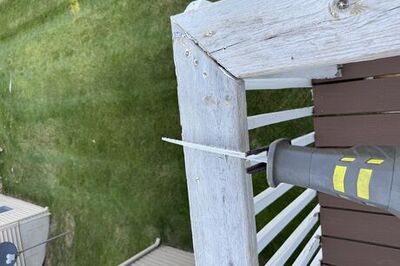
views
New Orleans: Hurricane Isaac lashed New Orleans as it approached the storied city on Wednesday morning exactly seven years after the devastating Katrina, knocking out power to hundreds of thousands and pushing flood waters over a levee in a rural area where authorities said some people may be trapped.
The US National Hurricane Center warned that dangerous storm surges and flooding threats from heavy rain were expected to last into the night as Isaac crawled from the Gulf Coast over Louisiana. The storm killed 24 in Haiti and five in the Dominican Republic over the weekend.
The director of the US National Hurricane Center, Rick Knabb, reminded people that the first half of Isaac hadn't moved through the area yet, and the region could see another day of the storm.
The full picture of the hurricane's damage was not yet clear. "It's going to be frustrating," the administrator of the Federal Emergency Management Agency, Craig Fugate, said on Wednesday. "The response will start when conditions allow, not when the sun shines."
The storm was far less strong than Katrina, which left 1,800 dead but resulted in the widespread strengthening of the city's flood defenses. Still, tens of thousands of people in low-lying Louisiana and Mississippi had been told to leave before Isaac arrived.
The center of Isaac, a lowest-category hurricane, was about 50 miles (80 kilometers) south-southwest of New Orleans, bringing the threat of almost two feet (0.6 meters) of rain to a region where many areas are under sea level.
Wind gusts of more than 60 miles (96 kilometers) per hour and sheets of rain raked the nearly empty streets of New Orleans after Isaac came ashore Tuesday night and drove a wall of water nearly 11 feet (3.3 meters) high inland. The National Weather Service said more than 9 inches (228 millimeters) of rain had fallen in New Orleans by 7 a.m. (1100 GMT).
Authorities said a storm surge topped an 18-mile (29-kilometer) stretch of flood wall in a thinly populated part of Plaquemines Parish. The levee is not part of New Orleans' defenses but is one of many in the region.
Parish authorities believed some people may be trapped in their homes despite an earlier evacuation. Rescuers were waiting for the winds to die down before moving out to search.
"We did have two parish police officers that were stuck in a car there. We just found out they were rescued and are safe," said emergency management spokeswoman Caitlin Campbell. Two other parish workers in a boat rescued them.
The storm also flooded beachfront roads before dawn in Louisiana and Mississippi.
Isaac's slow track meant the storm could dump up to 20 inches (508 millimeters) of rain in some areas, said Ken Graham, chief meteorologist at the National, Weather Service office in Slidell, Louisiana.
"I feel safe," said New Orleans resident Pamela Young, who was riding out the storm in a new, two-story home built to replace the one destroyed by Katrina.
"If the wind isn't too rough, I can stay right here," she said, tapping her living room table. "If the water comes up, I can go upstairs."
Power was knocked out to more than 500,000 customers across southern Louisiana, most of them in New Orleans.
The storm has drawn intense scrutiny because of its timing __ coinciding with Katrina and the first major speeches of the Republican National Convention in Florida, already delayed and tempered by the storm.
Katrina became a symbol of government ignorance and ineptitude, and President Barack Obama has sought to demonstrate his ability to guide the nation through a natural disaster, saying Americans will help each other recover "no matter what this storm brings."




















Comments
0 comment